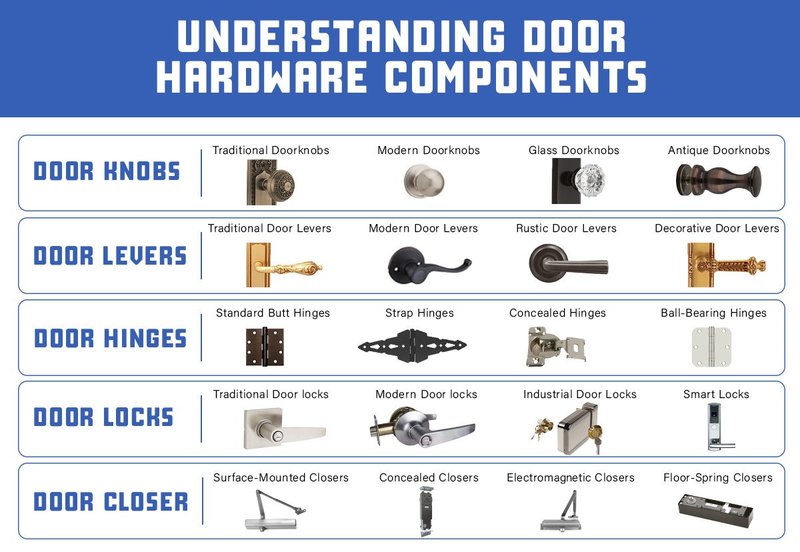
Picture this: you’re walking through a hardware store, looking at various door handles and locks. Some look shiny and new, while others seem a bit worn out. How do you tell what’s quality and what’s not? Just like choosing a ripe fruit, you want to feel confident that the door hardware you select will withstand the test of time. Let’s dive into the best ways to identify quality door hardware components so you can make informed decisions.
Understanding the Types of Door Hardware Components
Before we start identifying quality, let’s unpack what we mean by door hardware components. These include everything from door handles, locks, hinges, and knobs to more specialized pieces like strike plates and pivots. Each piece serves a specific function, and understanding these functions will help you recognize quality.
– Locks: The heart of security. They come in various types, including deadbolts and smart locks.
– Handles and Knobs: These are your primary means of opening and closing doors; they should feel solid and comfortable.
– Hinges: Often overlooked, these should be sturdy enough to hold the weight of the door.
Knowing the different components gives you a foundational understanding. When you know what you’re looking for, it becomes easier to spot quality amidst the options.
Material Matters: What To Look For
The material used in door hardware can significantly affect its performance and lifespan. Typical materials include stainless steel, brass, aluminum, and plastic. Each has its strengths and weaknesses.
– Stainless Steel: Known for its durability and resistance to rust and corrosion, making it perfect for exterior doors.
– Brass: This classic option is aesthetically pleasing and ages beautifully but can tarnish over time if not maintained.
– Aluminum: Lightweight and often used in commercial settings; it’s generally less durable than steel or brass but can be a budget-friendly option.
When evaluating door hardware, don’t just look at how it feels in your hand. Check the finish and see if it holds up to scratches or dings. A quality finish isn’t just for looks; it protects the hardware from wear and tear.
The Weight Test: Feel the Quality
Here’s a simple way to gauge quality: pick up the hardware and feel the weight. Quality door hardware is generally heavier and denser than cheaper alternatives. Why does this matter? Well, heavier hardware often uses more robust materials, making it less likely to wear out quickly.
– Knobs and Handles: A solid door handle should have a heft that feels reassuring in your palm. If it feels flimsy or rattles, it’s probably not a good choice.
– Locks: A good lock will feel solid and might even have a reassuring click when you engage it.
It’s a small tip, but seriously, next time you’re in a store, give items a good feel. It’s often a telltale sign of quality.
Checking Certifications and Ratings
Another great way to identify quality door hardware is to look for certifications and ratings. Many door hardware components undergo rigorous testing to meet industry standards. Here are a few terms to look for:
– ANSI/BHMA Ratings: These ratings indicate the durability and strength of locks and latches. A grade of 1 is the highest quality, while grade 3 is more suitable for residential use.
– UL Listed: If you see this, it means the hardware has been tested for fire safety.
When you’re shopping, ask a knowledgeable staff member or look online to check for these certifications. It provides an extra layer of reassurance about what you’re purchasing.
Examining Design and Aesthetics
Quality isn’t just about strength; it’s also about aesthetic appeal. The design of door hardware can elevate your entire space. Look for pieces that mesh well with your home style, whether modern, rustic, or traditional.
Take note of the following:
– Finish: Look for finishes that resist fingerprints and tarnishing. Matte finishes tend to hide wear better than shiny ones.
– Style: Ensure the design coordinates with the door and surrounding decor. For example, a sleek stainless-steel handle works well in a contemporary home, while an ornate brass knob might better suit a Victorian style.
A well-designed piece not only serves a function but also adds charm to your doorways.
Understanding Warranty and Customer Support
Quality door hardware should come with a warranty—this shows the manufacturer’s confidence in their product. A good warranty typically covers defects and issues for several years. If the warranty is short or nonexistent, consider that a red flag.
– Customer Support: Before you buy, check the manufacturer’s reputation for customer service. Quality companies usually have responsive support to help with installation or issues down the line.
Having reliable support can save you a headache if things don’t go as planned.
Installation and Maintenance Tips
Even the best door hardware can underperform if not installed correctly. Follow these tips to ensure longevity:
1. Read Instructions: Always refer to the manufacturer’s installation guide. It might seem tedious, but it can save you from mistakes.
2. Use the Right Tools: Investing in the correct tools can make installation smoother and your hardware more secure.
3. Regular Maintenance: Keep hinges lubricated and clean handles and locks to prevent wear. A little upkeep goes a long way.
The better you install and maintain your door hardware, the longer it will last, giving your home quality and security.
Identifying quality door hardware components is about more than just making a purchase—it’s about investing in your home’s security and style. From understanding materials and weight to checking ratings and warranties, each step plays an essential role in ensuring you choose the right pieces.
So next time you’re shopping for door hardware, remember: it’s not just about what looks good; it’s about functionality, durability, and the peace of mind that comes with quality. Armed with this knowledge, you can confidently select hardware that will stand the test of time and enhance your home. Happy shopping!
